Last updated: August 11, 2025
Article
Climate and Water Monitoring at White Sands National Park: Water Year 2023

NPS
Overview
Together, climate and hydrology shape ecosystems and the services they provide, particularly in arid and semi-arid ecosystems. Understanding changes in climate, groundwater, and surface water is key to assessing the condition of park natural resources—and often, cultural resources.
At White Sands National Park (Figure 1), Chihuahuan Desert Inventory and Monitoring Network scientists study how ecosystems may be changing by taking measurements of key resources, or “vital signs,” year after year—much as a doctor keeps track of a patient’s vital signs. This long-term ecological monitoring provides early warning of potential problems, allowing managers to mitigate them before they become worse. At White Sands National Park, we monitor climate, groundwater, and springs, among other vital signs.
Surface water and groundwater conditions are closely related to climate conditions. Because they are better understood together, we report on climate in conjunction with water resources. Reporting is by water year (WY), which begins in October of the previous calendar year and goes through September of the water year (e.g., WY2023 runs from October 2022 through September 2023). This web report presents the results of climate and water monitoring at White Sands National Park in WY2023.
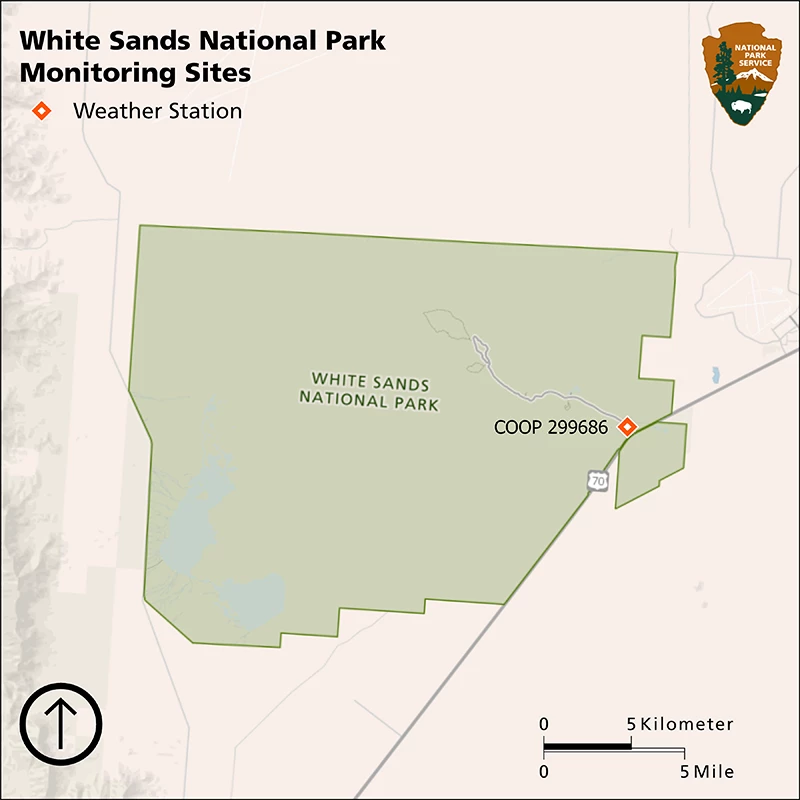
NPS
Climate and Weather
There is often confusion over the terms “weather” and “climate.” In short, weather describes instantaneous meteorological conditions (e.g., it’s currently raining or snowing, it’s a hot or frigid day), and climate reflects patterns of weather at a given place over longer periods of time (seasons to years). Climate is the primary driver of ecological processes on Earth. Climate and weather information provide context for understanding the status or condition of other park resources.
Methods
A National Oceanic and Atmospheric Administration Cooperative Observer Program (NOAA COOP) weather station (White Sands Natl Mon #299686) has been operational at White Sands National Park since 1939 (Figure 1). The White Sands Natl Mon station typically provides a reliable climate dataset. However, in WY2023 the station was missing data on 28 days. As a substitute, climate analyses in this year’s report use current year and 30-year averages (1991–2020) of gridded surface meteorological (GRIDMET) data from the location of the COOP station. Subsequent reports may revert to the weather station as the data source depending on future data quality.
GRIDMET is a spatial climate dataset at a 4-kilometer resolution that is interpolated using weather station data, topography, and other observational and modeled land surface data. Temperature and precipitation estimated from GRIDMET may vary from actual weather at a particular location depending on the availability of weather station data and the difference in elevation between the location and that assigned to a grid cell. Data from both weather stations and GRIDMET are accessible through Climate Analyzer.
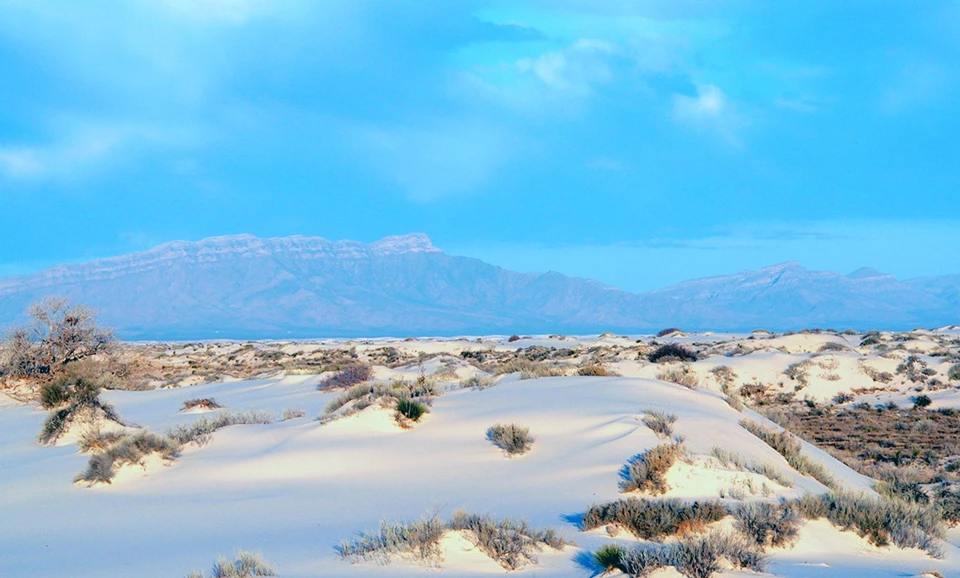
NPS
Precipitation
Annual precipitation at White Sands National Park in WY2023 was 5.92″ (15.0 cm), 3.54″ (9.0 cm) less than the 1991–2020 annual average. In WY2023, only September received more than average precipitation (Figure 2). Precipitation totals in October, February, May, June, and August were slightly to moderately below the 1991–2020 averages. Substantially below average precipitation (≤ 51% of average) occurred in December, January, March, and July. November and April were completely dry. The largest single month precipitation deficit occurred in July, which only received 0.20″ (0.51 cm), compared to the average of 1.59″ (4.0 cm).
Air Temperature
The mean annual maximum temperature at White Sands National Park in WY2023 was 78.3°F (25.7°C), 0.2°F (0.1°C) below the 1991–2020 average. The mean annual minimum temperature in WY2023 was 43.9°F (6.6°C), 0.7°F (0.4°C) above the long-term average. Mean monthly maximum temperatures were below the 1991–2020 averages by as much as 5.2°F (2.9°C) in October–June, except in December (Figure 2). Mean monthly minimum temperatures oscillated above and below the long-term averages in October–June and were frequently very close to the average. Both mean monthly maximum and minimum temperatures were above average by up to 4.5°F (2.5°C) in July–September.
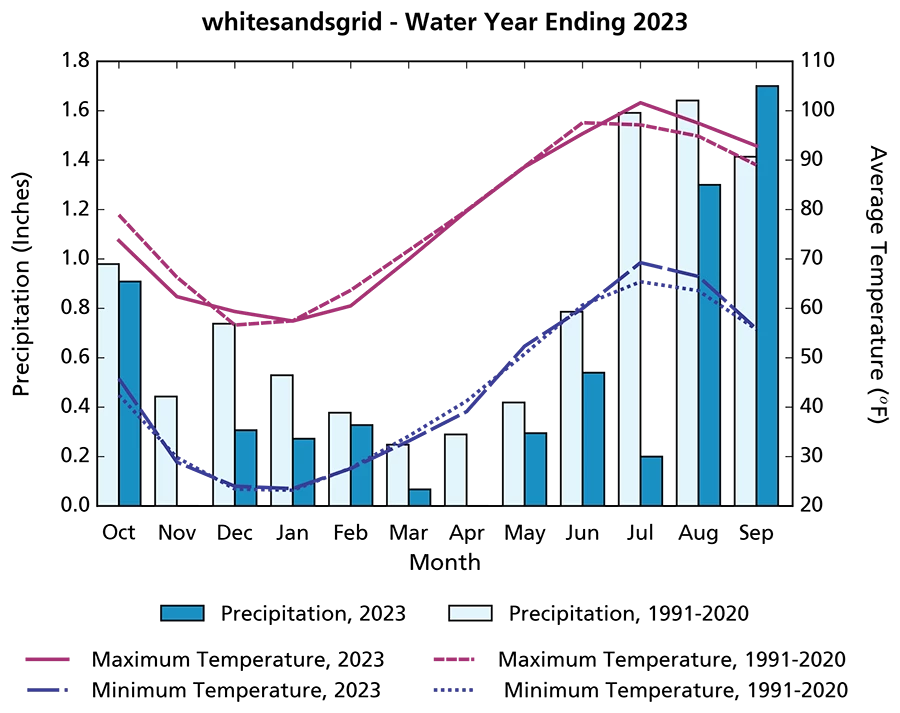
NPS
Drought
Reconnaissance drought index (Tsakiris and Vangelis 2005) provides a measure of drought severity and extent relative to the long-term climate. It is based on the ratio of average precipitation to average potential evapotranspiration (the amount of water loss that would occur from evaporation and plant transpiration if the water supply was unlimited) over short periods of time (seasons to years). The reconnaissance drought index for White Sands National Park indicates that WY2023 was drier than the 1991–2023 average from the perspective of both precipitation and potential evapotranspiration (Figure 3).
Reference: Tsakiris G., and H. Vangelis. 2005. Establishing a drought index incorporating evapotranspiration. European Water 9: 3–11.
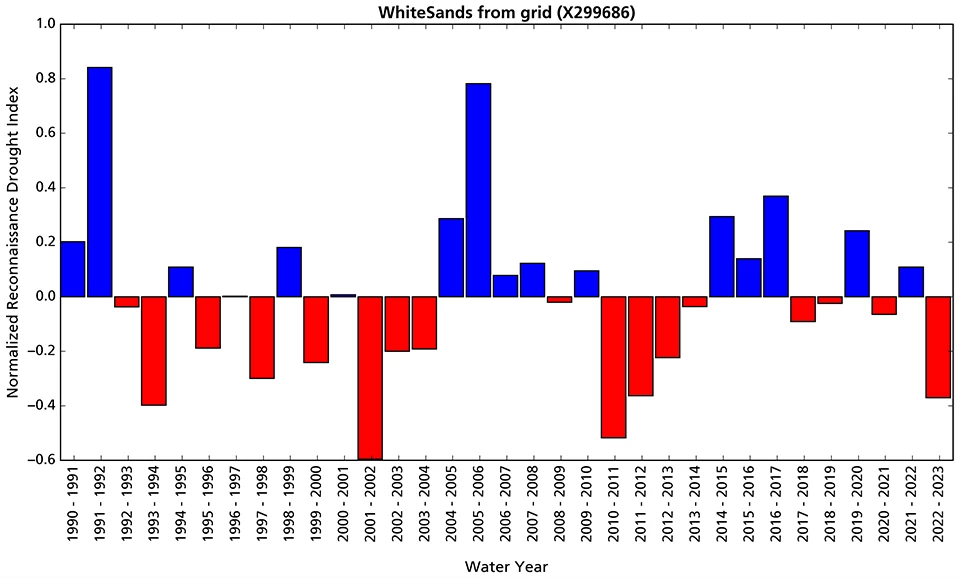
NPS
Springs
Background
Springs, seeps, and tinajas (discrete pools in a rock basin or impoundments in bedrock) are small, relatively rare biodiversity hotspots in arid lands. They are the primary connection between groundwater and surface water and are important water sources for plants and animals. For springs, the most important questions we ask are about persistence (How long was there water in the spring?) and water quantity (How much water was in the spring?). Springs reporting is by water year (WY), which begins in October of the previous calendar year and goes through September of the current calendar year (e.g., WY2023 runs from October 2022 through September 2023). WY2023 springs sampling at White Sands National Park occurred on 26 January and 22 March 2023. Water persistence is monitored continuously throughout the water year, but in this report we only present WY2023 persistence data up to the springs sampling visit date.
Methods
Chihuahuan Desert Network springs monitoring is organized into the four modules described below.
Site Characterization
This module provides context for interpreting change in the other modules. We record GPS locations, draw a site diagram, and describe the spring type (e.g., helocrene, limnocrene, rheocrene, or tinaja) and its associated vegetation in this module. Helocrene springs emerge as low-gradient wetlands, limnocrene springs emerge as pools, and rheocrene springs emerge as flowing streams. This module is completed once every five years or after significant events.
Site Condition
We estimate the level of natural and anthropogenic disturbances and the level of stress on vegetation and soils at the spring on a scale of 1–4, where 1 = undisturbed, 2 = slightly disturbed, 3 = moderately disturbed, and 4 = highly disturbed. Types of natural disturbances can include flooding, drying, fire, wildlife impacts, windthrow of trees and shrubs, beaver activity, and insect infestations. Anthropogenic disturbances can include roads, off-highway vehicle trails, hiking trails, livestock and feral-animal impacts, removal of invasive non-native plants, flow modification, and other evidence of human use of the spring site. We take repeat photographs from the same location and perspective to show the spring and its landscape context. We note the presence of certain obligate wetland plant species (plant species that almost always occur only in wetlands), facultative wetland plant species (plant species that usually occur in wetlands but also occur in other habitats), and invasive non-native crayfish and bullfrogs (American bullfrog [Lithobates catesbeianus]). We also record the density of invasive non-native plants using a qualitative scale (1–5 plants, scattered patches, evenly distributed patches, or a matrix).
Water Quantity
We measure the persistence of surface water, amount of spring discharge, and wetted extent (area that contained water). To estimate persistence, we analyze the variance of temperature measurements taken by logging thermometers placed at or near the orifice (spring opening). Because water mediates variation in diurnal temperatures, data from a submerged sensor will show less daily variation than data from an exposed, open-air sensor; this tells us when the spring was wet or dry. Surface discharge is measured with a timed sample of water volume. Wetted extent is a systematic measurement of the physical length (up to 100 m), width, and depth of surface water. It is assessed using a technique for either standing water (e.g., limnocrene and helocrene springs) or flowing water (e.g., rheocrene springs).
Water Quality
We measure core water quality and water chemistry parameters. Core water quality parameters include water temperature, pH, specific conductivity (a measure of dissolved compounds and contaminants), dissolved oxygen (how much oxygen is present in the water), and total dissolved solids (an indicator of potentially undesirable compounds). Discrete measurements of these parameters are collected with a multiparameter meter. If the meter fails calibration checks, we do not present data. Water chemistry is assessed by collecting surface water sample(s) and estimating the concentration of major ions with a photometer in the field. These parameters are collected at one or more sampling locations within a spring. Data are presented only for the primary sampling location within each spring. Each perennial spring is somewhat unique, and New Mexico has not adopted water quality standards that would apply across the diversity of springs described here. Ongoing, long-term data collection at each spring will improve our understanding of the natural range in water quality and water chemistry parameters for a given site.
List of Springs
Scroll down or click on a spring below to view monitoring results.
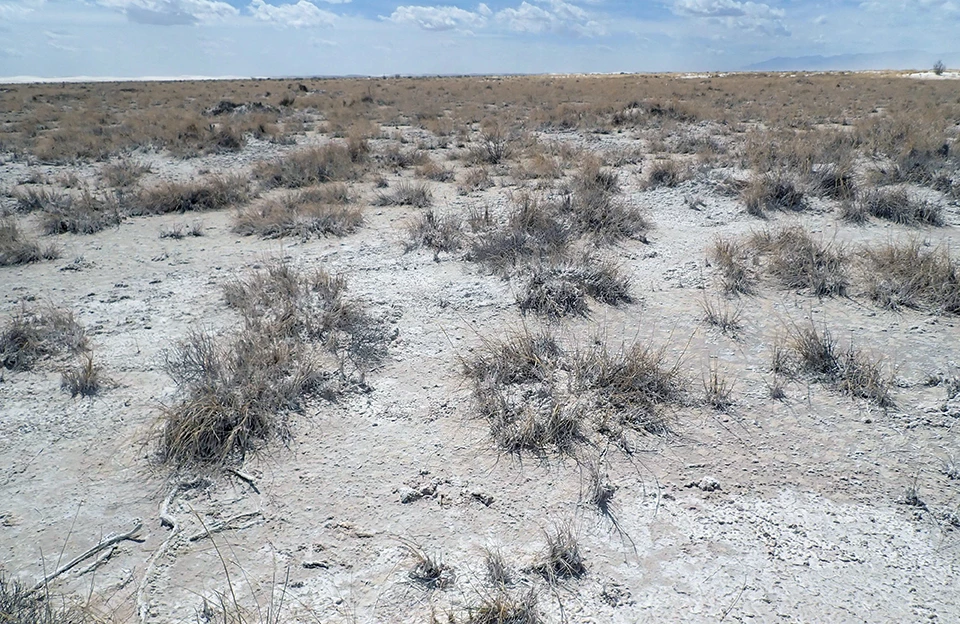
NPS
EC-30 Spring
EC-30 Spring (Figure 4) cannot be characterized by a single spring type, so we categorize it as “other,” although it is closest to a helocrene spring (low-gradient wetland) or limnocrene spring (spring that emerges as a pool). The spring is in a flat, open area near the northeast corner of White Sands National Park and emerges from multiple orifices across the landscape. These orifices form distinct potholes less than 30 cm in diameter and of varying depths (0.0–0.5 m). When the water table is high, the surrounding area is submerged under shallow, standing water, and when it is low, the potholes are the only wetted areas. The WY2023 visit occurred on 22 March 2023, and the spring was wetted (contained water).
Site Condition
In WY2023, we rated EC-30 Spring (Figure 5) slightly disturbed by contemporary human use based on a well-maintained barbed-wire fence on the spring periphery (rated undisturbed to moderately disturbed in the past); slightly disturbed by non-native, feral animals because of scat and footprints from oryx (Oryx gazella) throughout the spring area (rated undisturbed to slightly disturbed in the past); moderately disturbed by roads/ohv trails, with a minimally developed dirt road located 10–40 m away from the spring orifices (rated undisturbed to moderately disturbed in the past); and highly disturbed by exotic plant removal because of previous Tamarix treatment (rated slightly to moderately disturbed in the past). No other natural or human-caused disturbances were observed at EC-30 Spring in WY2023.
As in past years, we did not observe invasive non-native crayfish or American bullfrog (Lithobates catesbeianus) at EC-30 Spring in WY2023. We observed one invasive non-native plant: 1–5 tamarisk individuals (Tamarix sp.; 1–5 plants to scattered patches observed in 2019–2021).
We did not observe any obligate/facultative wetland plants at EC-30 Spring in WY2023.
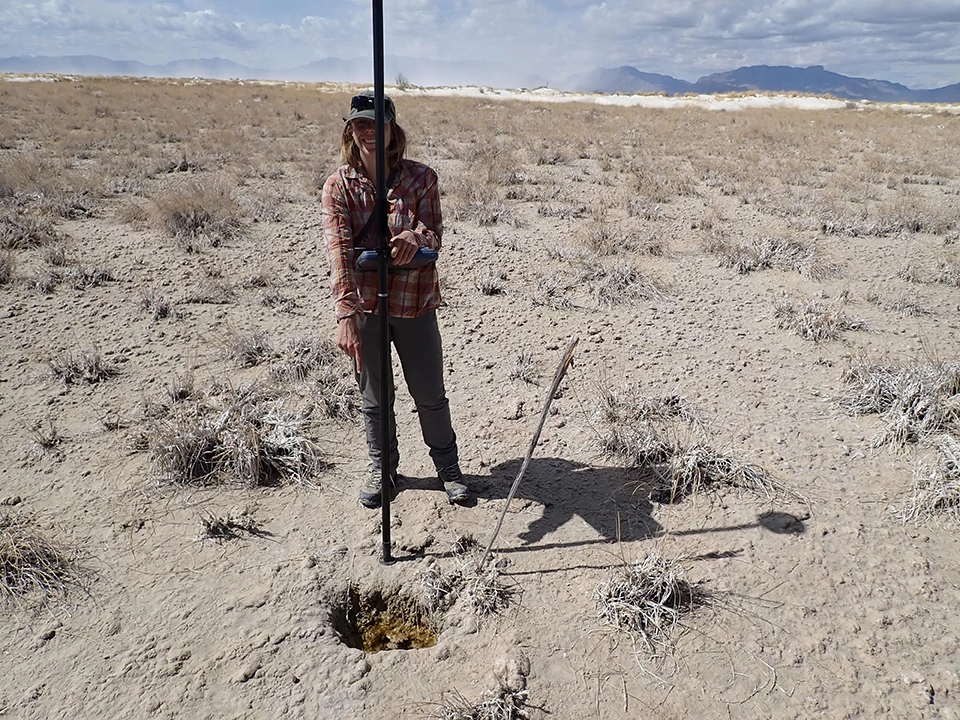
NPS
Water Quantity
Sensors are deployed and data are downloaded during our annual visit, which takes place in the middle of the water year; the dates of these visits are indicated by black diamonds in the persistence graph (Figure 6). The temperature sensor indicated that EC-30 Spring was wetted for 173 of 173 days (100%) measured up to the WY2023 visit. In prior water years, the spring was wetted 52.6–100% of the days measured across entire water years.

NPS
As in past years, there was no measurable discharge at EC-30 Spring due to lack of surface flow and gradient.
Wetted extent was also not measured because our standard methods for standing water are not feasible at this site. We are exploring alternate methods to measure wetted extent at the site in the future.
Water Quality
Core water quality (Table 1) and water chemistry (Table 2) data were collected at the primary sampling location at orifice B (Figure 5). Dissolved oxygen and total dissolved solids levels were within the ranges of prior values. Specific conductivity and temperature values were lower than in past years. The pH probe failed a post-calibration check, so pH data are not available for the WY2023 visit. Alkalinity, calcium, chloride, magnesium, potassium, and sulphate values were all within the ranges of prior measurements.
EC-30 Spring Data Tables
| Sampling Location | Measurement Location | Parameter | WY2023 Value (range of prior values) |
Prior Years Measured (# of measurements) |
|---|---|---|---|---|
| 002 | Center | Dissolved oxygen (mg/L) | 5.08 (3.32–6.78) |
2017–2022 (8) |
| 002 | Center | pH | n.d. (7.55–8.54) |
2017–2022 (8) |
| 002 | Center | Specific conductivity (µS/cm) | 4,722 (4,780–5,030) |
2018–2022 (3) |
| 002 | Center | Temperature (°C) | 10.9 (12.7–16.2) |
2017–2022 (10) |
| 002 | Center | Total dissolved solids (mg/L) | 3,069.0 (3,009.5–3,276.0) |
2017–2022 (8) |
| Sampling Location | Measurement Location (width, depth) |
Parameter | WY2023 Value (range of prior values) |
Prior Years Measured (# of measurements) |
|---|---|---|---|---|
| 002 | Center | Alkalinity (CaCO3) |
57 (51–67) |
2017–2022 (5) |
| 002 | Center | Calcium (Ca) |
520 (510–600) |
2017–2022 (5) |
| 002 | Center | Chloride (Cl) |
470 (410–480) |
2017–2022 (5) |
| 002 | Center | Magnesium (Mg) |
260 (180–270) |
2017–2022 (5) |
| 002 | Center | Potassium (K) |
15 (14–15) |
2017–2022 (5) |
| 002 | Center | Sulphate (SO4) |
2,400 (2,300–2,500) |
2017–2022 (5) |
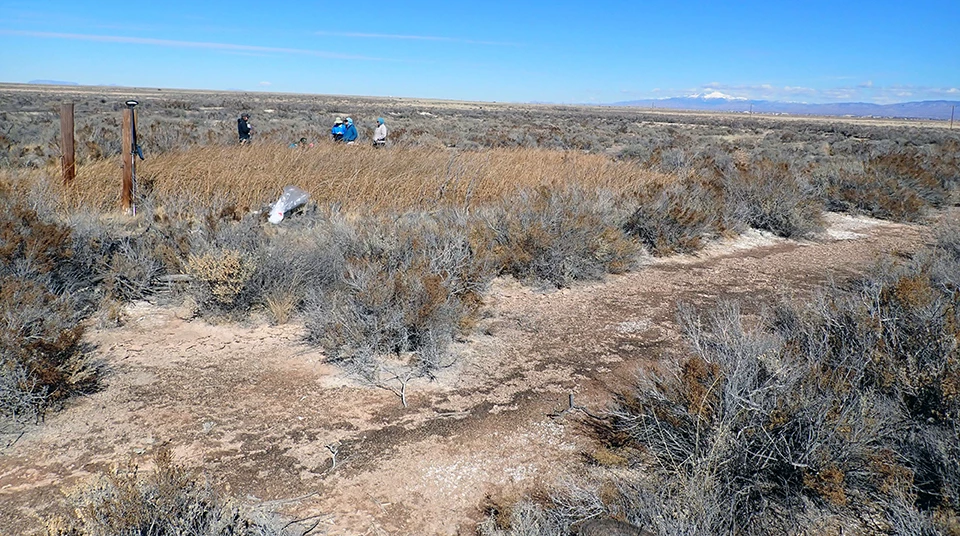
NPS
Garton Pond
Garton Pond (Figure 7) is a helocrene spring (a spring that emerges into marshy, wet meadow settings—low-gradient wetlands). The wetland area is about 20 m long, between 5 and 10 m wide, and 0.2–0.8 m deep. A dense stand of bulrush (Schoenoplectus sp.) populates the pool. The WY2023 visit occurred on 26 January 2023, and the spring was wetted (contained water).
Site Condition
In WY2023, we rated Garton Pond (Figure 8) slightly disturbed by roads/ohv trails based on a park staff road leading to the spring (rated moderately to highly disturbed in the past); slightly disturbed by exotic plant removal because of cut Tamarix stumps surrounding the spring (rated slightly to moderately disturbed in the past); slightly disturbed by drying, with evidence that the spring was confined to a smaller section of a larger depression that could have once held more water (rated undisturbed to slightly disturbed in the past); and slightly disturbed by wildlife based on scat, trails leading into the spring, and dug up sediment piles (rated undisturbed to slightly disturbed in the past). No other natural or human-caused disturbances were observed at Garton Pond in WY2023.
As in past years, we did not observe invasive non-native crayfish or American bullfrog (Lithobates catesbeianus) at Garton Pond in WY2023, nor did we observe any invasive non-native plants.
We observed one obligate/facultative wetland plant at Garton Pond in WY2023: bulrush (Schoenoplectus sp., a sedge observed in 2017–2021).
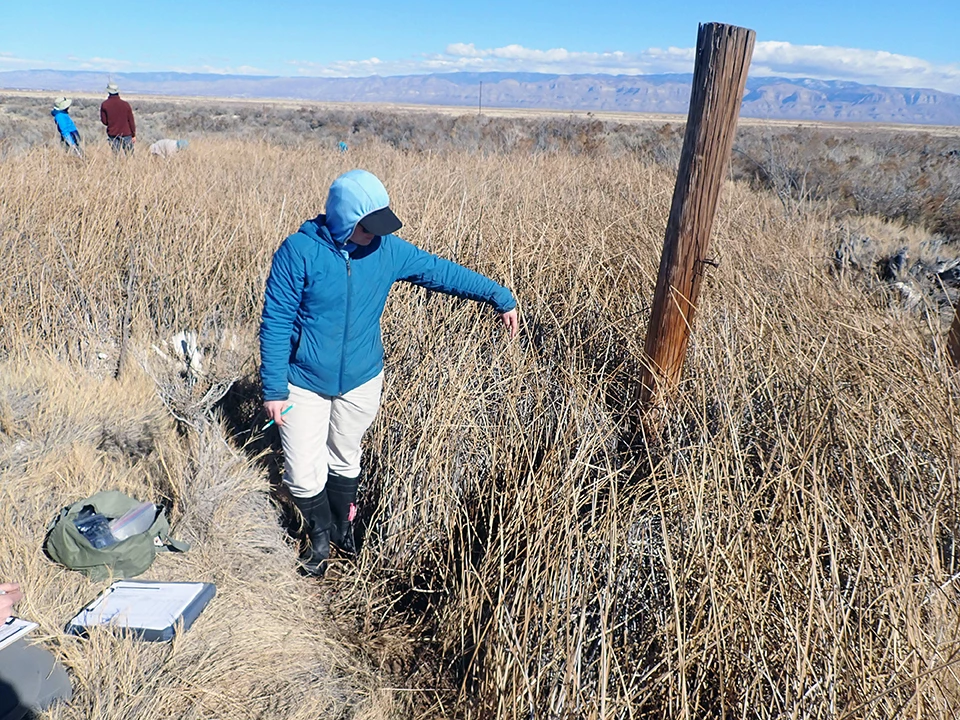
NPS
Water Quantity
Sensors are deployed and data are downloaded during our annual visit, which takes place in the middle of the water year; the dates of these visits are indicated by black diamonds in the persistence graph (Figure 9). The temperature sensor indicated that Garton Pond was wetted for 118 of 118 days (100%) measured up to the WY2023 visit (Figure 5). In prior water years, the spring was wetted 42.5–100% of the days measured across entire water years.

NPS
As in past years, there was no measurable discharge due to a lack of surface flow in WY2023.
Wetted extent was evaluated using a method for standing water. Width averaged 6.8 m (22.3 ft), depth averaged 1.7 cm (0.7 in), and length averaged 14.8 m (48.6 ft) in WY2023. The width and length of the spring were consistent with previous measurements, while depth was lower than in previous years. (Table 3).
Water Quality
Core water quality (Table 4) and water chemistry (Table 5) data were collected at the primary sampling location in the deepest part of the pool (Figure 8). Dissolved oxygen, specific conductivity, and total dissolved solids values were consistent with ranges of previous measurements. Temperature was lower than prior years, while pH was higher than in the past. Alkalinity, calcium, and magnesium values were all consistent with prior years. Chloride and sulphate values were higher than in the past, and the level of potassium was lower.
Garton Pond Data Tables
| Measurement | WY2023 Mean (range of prior means) |
Prior Years Measured (# of visits with measurements) |
|---|---|---|
| Width (m) | 6.8 ± 34.0 (0.9–7.7) | 2017–2021 (4) |
| Depth (cm) | 1.7 ± 1.5 (2.2–5.8) | 2017–2021 (4) |
| Length (cm) | 14.8 ± 4.8 (1.4–19.5) | 2017–2021 (4) |
| Sampling Location | Measurement Location (width, depth) |
Parameter | WY2023 Value (range of prior values) |
Prior Years Measured (# of measurements) |
|---|---|---|---|---|
| 002 | Center | Dissolved oxygen (mg/L) | 7.06 (4.00–8.30) |
2018–2022 (3) |
| 002 | Center | pH | 7.23 (6.96–7.09) |
2018–2022 (3) |
| 002 | Center | Specific conductivity (µS/cm) | 12,444 (12,219–12,730) |
2018–2022 (3) |
| 002 | Center | Temperature (°C) | 1.9 (11.6–17.6) |
2018–2022 (4) |
| 002 | Center | Total dissolved solids (mg/L) | 8,087 (7,943–8,274) |
2018–2022 (3) |
| Sampling Location | Measurement Location (width, depth) |
Parameter | WY20223Value (range of prior values) |
Prior Years Measured (# of measurements) |
|---|---|---|---|---|
| 002 | Center | Alkalinity (CaCO3) |
100 (90–100) |
2017–2022 (5) |
| 002 | Center | Calcium (Ca) |
690 (640–710) |
2017–2022 (5) |
| 002 | Center | Chloride (Cl) |
3,000 (2,800–2,900) |
2017–2022 (5) |
| 002 | Center | Magnesium (Mg) |
190 (170–200) |
2017–2022 (5) |
| 002 | Center | Potassium (K) |
15 (35–42) |
2017–2022 (5) |
| 002 | Center | Sulphate (SO4) |
3,700 (3,100–3,400) |
2017–2022 (5) |
Report Citation
Authors: Susan Singley, Kara Raymond, Arturo Aguilar
Singley, S., K. Raymond, and A. Aguilar. 2025. Climate and Water Monitoring at White Sands National Park: Water Year 2023. Chihuahuan Desert Network, National Park Service, Las Cruces, New Mexico.
